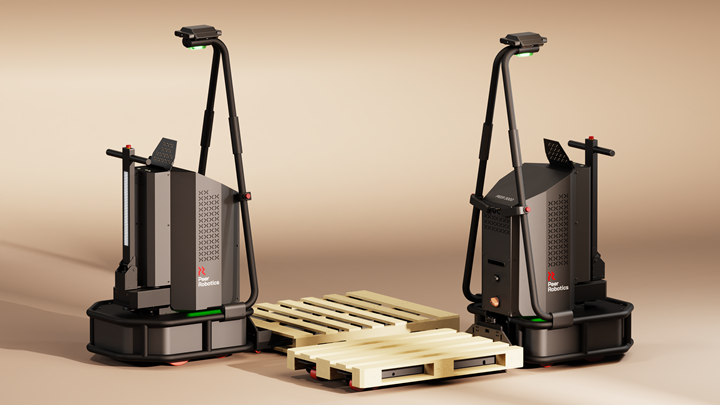Beyond the Humanoid Hype: Why Collaborative Mobile Robots Are the Real Factory Floor Revolution

The robotics industry is in the midst of a fascinating paradox. Prototypes of humanoid, general-purpose robots steal mainstream headlines, but the real robotic transformations happening on factory floors and in warehouses are an entirely different breed of automated machine. Collaborative mobile robots are already delivering measurable results for companies across a variety of industries, and they’re fulfilling promises that the sci-fi-esque robots can only dream of one day tackling.
The Humanoid Distraction
Humanoid robots — like Tesla’s Optimus or Boston Dynamics’ Atlas — represent incredible leaps forward in engineering, and could dramatically impact certain industries… someday. Today, however, these incredibly impressive machines are still finding their footing, with very few units being used in real-world manufacturing or industrial applications, and most not yet available in any form.
Costs and application specific ROI are a major hurdle for humanoid robots as well, with units costing hundreds of thousands of dollars. Additionally, supporting safety infrastructure and extensive programming are absolute necessities, making them far from plug-and-play. Even when these machines are well-oiled and working as intended, they are often limited to relatively basic tasks which make them an unappealing proposition for small to medium-sized operations.
Human-like robots may seem like a sort of holy grail for industrial productivity, but their dexterity and flexibility come at the cost of reliability and simplicity — two things that manufacturers value above almost anything else. They are the “Jack of all trades” but the master of none, and since they are designed with the end goal of replacing humans, they don’t inherently work well alongside us.
Augmenting Humans, Not Replacing Them
While some in the industrial and manufacturing space look at humanoid robots a dream come true, collaborative mobile robots are quietly revolutionizing many different manufacturing operations with a fundamentally different approach. Instead of designing a machine to replace human workers, these automated systems handle grunt work like material handling and inventory management that delay and distract human workers from the tasks that only they can do.
Collaborative mobile robots have many inbuilt advantages over their human-shaped counterparts. They’re generally more affordable — and deliver more rapid ROI. Utilizing these types of robots doesn’t require vast infrastructure changes or accommodations, and they’re capable of navigating virtually any environment with built-in safety mechanisms and highly advanced machine vision capabilities.
The Peer 3000 platform, for example, can be deployed in an industrial or warehouse setting and will automatically identify existing pallets, trolleys, and carts, interacting with them without any additional modifications. Enterprises can begin benefiting from this technology with as little as a single unit, scaling their robot workforce as their business grows.
Perhaps most importantly, collaborative mobile robots are designed specifically to work alongside humans. They keep a watchful eye over their environment, avoid obstacles, and actively learn from human workers. When integrating these robots into a workflow, a human worker can teach each robot where to travel to within any floorplan, what materials to transport, and where to drop them off, all without typing a single line of code.
Real-World Impact in Action
Collaborative mobile robots get their jobs done quickly, efficiently, and safely, but there are additional benefits that extend beyond the robot itself.
Reduced human strain and injury: The handling of materials is one of the leading causes of workplace injury in manufacturing. By automating these repetitive and tedious tasks, the robots eliminate the physical strain that so often leads to fatigue and injury.
Enhanced workforce productivity: Collaborative mobile robots are not designed to replace human workers. In fact, by handing off busywork and simple jobs to a robot, human workers are free to address tasks that require their individual skill, dexterity, and attention. Humans spend less time carrying parts from one spot to another and more time spent doing the jobs that only they can do.
Adaptive problem-solving: Modern collaborative mobile robots are built around AI and machine learning software that quickly identifies objects, places, obstacles, and of course people. They can rapidly adapt to a changing facility layout and regular updates mean they continue to get smarter over time.
Building Data Pipeline: collaborative mobile robots are equipped with a range of advanced vision sensors, enabling them to capture real-world data. This powerful data pipeline enables dynamic digital twins of manufacturing operations. The insights and feedback generated from this data empower manufacturers to continuously optimize workflows and make smarter, data-driven decisions.
The Robot of the Future?
One of the most significant limitations of humanoid robots is that many manufacturing facilities and warehouse environments simply weren’t designed with human-scale robots in mind, and certainly not for both humanoid robots and human workers to work side-by-side. Safety requirements alone can transform what should be a simple automation project into a full-scale renovation.
Collaborative mobile robots, on the other hand, are built specifically for existing infrastructure, including the rapidly-aging factory settings that are so common throughout the United States. We regularly see manufacturers integrate collaborative mobile robots within a few short weeks rather than months, seeing immediate boosts to productivity as they plan their larger-scale automation strategies.
Robotics as an industry has always been plagued by hype cycles, and it’s understandable. A human-shaped robot that walks around your shop floor would definitely make you feel like you’re living in the future. Unfortunately, the technology just isn’t quite ready for its time in the spotlight, and the cost, safety, and integration headaches that come with these bots is putting them far out of reach for the majority of companies.
The future of manufacturing, for now anyway, lies in a collaborative approach where skilled workers do what they do best and purpose-built robots do the monotonous heavy lifting. The exciting reality is that this revolution is happening right now, in factories all over the US and beyond, with robots optimizing workflows and proving their worth in weeks, not years.
The question isn’t whether manufacturers should embrace robotics, it’s whether they’ll choose the solutions that are already delivering results now, or wait for the promises of tomorrow which may never become reality.
 Rishabh Agarwal is the Co-Founder and CEO of Peer Robotics, a collaborative mobile robotics startup with operations in the US and India. Coming from a family of small-scale manufacturers in India, he did his research along the lines of Human-Robot interaction from IIT Delhi, the University of Maryland, College Park, and Siemens in Germany. Over the last few years, he has been playing a more customer-centric role, interacting and working with end-users, building the next generation of collaborative mobile robots.
Rishabh Agarwal is the Co-Founder and CEO of Peer Robotics, a collaborative mobile robotics startup with operations in the US and India. Coming from a family of small-scale manufacturers in India, he did his research along the lines of Human-Robot interaction from IIT Delhi, the University of Maryland, College Park, and Siemens in Germany. Over the last few years, he has been playing a more customer-centric role, interacting and working with end-users, building the next generation of collaborative mobile robots.
Featured Product

